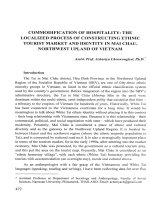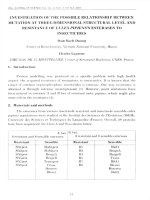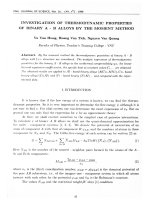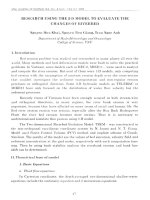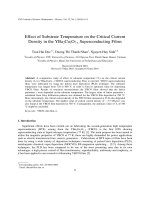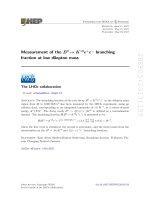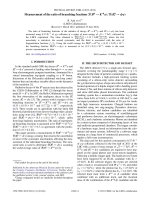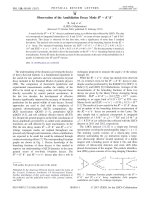DSpace at VNU: Detection of the sul1, sul2, and sul3 genes in sulfonamide-resistant bacteria from wastewater and shrimp ponds of north Vietnam
Bạn đang xem bản rút gọn của tài liệu. Xem và tải ngay bản đầy đủ của tài liệu tại đây (645.06 KB, 8 trang )
S CIE N CE OF T H E TOT AL E N V I RO N ME N T 4 0 5 ( 2 00 8 ) 3 7 7–3 84
a v a i l a b l e a t w w w. s c i e n c e d i r e c t . c o m
w w w. e l s e v i e r. c o m / l o c a t e / s c i t o t e n v
Detection of the sul1, sul2, and sul3 genes in
sulfonamide-resistant bacteria from wastewater
and shrimp ponds of north Vietnam
Phan Thi Phuong Hoa a,b , Lisa Nonaka a , Pham Hung Viet c , Satoru Suzuki a,⁎
a
Center for Marine Environmental Studies (CMES), Ehime University, Matsuyama, 790-8577, Japan
United Graduate School of Agricultural Science, Ehime University, Japan
c
Research Center for Environmental Technology and Sustainable Development (CETASD), Hanoi University of Science, Hanoi, Vietnam
b
AR TIC LE I N FO
ABS TR ACT
Article history:
To assess the presence and distribution of the sul genes (sul1, sul2, and sul3) and plasmids in
Received 7 March 2008
human-mediated environments of north Vietnam, we examined a total of 127 sulfonamide-
Received in revised form 4 June 2008
resistant (SR) bacterial isolates from four shrimp ponds (HNAQs), a city canal (HNCs) and
Accepted 9 June 2008
three fish ponds that received wastewater directly from swine farms (HNPs). Results from
Available online 6 August 2008
the SR isolates revealed that sul genes were most frequently detected in the HNPs (92.0%),
Keywords:
the most prevalent gene in all three environments (57.0, 33.0 and 60.0% in HNPs, HNAQs, and
followed by HNCs (72.0%), and the HNAQs (43.0%). Among the sul genes detected, sul1 was
Sulfonamide
HNCs, respectively) followed by sul2 (51.0, 19.0, and 20.0%, respectively) and sul3 (14.0, 6.0,
Resistance
and 8.0%, respectively). All combinations of paired different sul genes were detected, with
sul
the combination between sul1 and sul2 being the most frequent in all three environments
Vietnam
(20.0, 8.0, and 8.0% in HNPs, HNAQs, and HNCs, respectively). The combination of three sul
genes was detected at low frequencies (2–3%) in the HNPs and HNAQs, and was absent in the
HNCs. The sul genes were more frequently located on the chromosome than on plasmids.
The identification of SR isolates positive for the sul genes and plasmids showed that
Acinetobacter was the most dominant. Our study revealed that the sul genes were common in
SR bacteria from the aquatic environments we examined from northern Vietnam.
Wastewater from swine farms might be “hot spots” of the sul genes and plasmids and
may be reservoirs for the exchange of the sul genes among bacteria.
© 2008 Elsevier B.V. All rights reserved.
1.
Introduction
Sulfonamides, synthetic antibiotics, have been widely used to
treat bacterial and protozoan infections in humans, domestic
animals, and aquaculture since their introduction to clinical
practice in 1935 (Perreten and Boerlin, 2003; Le and Munekage,
2004; Blahna et al., 2006). Sulfonamides work by inhibiting
folate biosynthesis by competing with the natural substrate pamino-benzoic acid for binding to dihydropteroate synthase
(DHPS), an enzyme in the folic acid synthesis pathway.
Through this process, sulfonamides inhibit the formation of
dihydrofolic acid (Perreten and Boerlin, 2003). Bacterial
resistance to sulfonamides, however, can occur through
mutations in the chromosomal DHPS gene (folP) or through
acquisition of an alternative DHPS gene (sul), whose product
has a low affinity for sulfonamides (Perreten and Boerlin,
2003). Of the two pathways, the sul genes are the most
prevalent mechanism of sulfonamide resistance (Enne et al.,
2002; Perreten and Boerlin, 2003). Sulfonamide resistance (SR)
is globally prevalent within human and animal pathogens
⁎ Corresponding author. Tel./fax: +81 89 927 8552.
E-mail address: (S. Suzuki).
0048-9697/$ – see front matter © 2008 Elsevier B.V. All rights reserved.
doi:10.1016/j.scitotenv.2008.06.023
378
SC IE N CE OF T H E TOT AL E N V I RO N ME N T 4 0 5 ( 2 00 8 ) 3 7 7–3 84
(Kerrn et al., 2002; Perreten and Boerlin, 2003; Antunes et al.,
2005), however, the presence of the sul genes is not equally
distributed among bacterial populations (Kerrn et al., 2002;
Antunes et al., 2005; Hammerum et al., 2006).
Monitoring programs for antimicrobial resistance, including SR in agents of zoonoses and in indicator bacteria of normal
intestinal and pathogenic flora of animals (e.g., Escherichia coli,
Enterococus spp) have been established in Europe, North
America, and Latin America (Boerlin et al., 2005). However,
the persistence and spread of an antibiotic resistance gene may
occur not only to animal intestinal and pathogenic microbiota
but also to environmental bacteria (Aminov and Mackie, 2007).
Antibiotic resistance genes can be widely spread by horizontal
gene transfer within the environment. Recently, some studies
revealed the wide distribution of tetracycline resistance in
coastal areas of Japan and Korea (Nonaka et al., 2000; Kim et al.,
2003, 2004); however, limited information exists on the
presence of the sul genes in environmental bacteria of Asia
with only one known study on the sul2 among resistant Acinetobacter sp from Thailand (Agersø and Petersen, 2007).
In Vietnam, the unregulated use of antimicrobials in plant
protection, animal husbandry, aquaculture facilities, and
human and veterinary medicine may be a significant source of
antibiotic resistance (Le and Munekage, 2004; Le et al., 2005;
Cabello, 2006). Antibiotic resistance may be further enhanced
through polyculture practices that have been commonly used in
Southeast Asia and Vietnam. In Vietnam, a recycling farm
system, typically consisting of vegetable, aquaculture and cage
(VAC), has been in practice since the 1980s, in which animal
(usually pigs, chickens, and ducks) manure is directly transported to fish ponds, and to vegetable and rice fields. The VAC
system has been considered to be a very economical method of
farming (Hop, 2003); however the heavy use of antibiotics in farm
animals and subsequent waste discharge of antibiotic residues
and antibiotic-resistant bacteria has been shown to increase
bacterial antibiotic resistance in the surrounding environment
(Petersen and Dalsgaard, 2003; Heuer and Smalla, 2007).
The VAC system and other habitats such as city canals,
receive many anthropogenic sources, and may therefore be a
mixture of bacteria and drug resistance genes. In contrast, the
common shrimp ponds used in Vietnam which receive more
natural water have very specific sources of drug contamination. In this study, we tested the hypothesis that these
different aquatic habitats varied in their sul gene profile, and
that habitats with higher inputs (i.e. VAC and city canal) are
expressed as a mixture of the sul genes. To accomplish this,
we assessed the distribution of the sul genes and plasmids in
SR bacterial isolates from water samples collected from
different aquatic environments (fish ponds of VAC swine
farms, shrimp ponds and a city canal) of north Vietnam.
2.
Materials and methods
2.1.
Sample collection and isolation of sulfonamide-resistant
(SR) bacteria
Water samples from nine sites were taken, including three
fish ponds in three different VAC swine farms (HNPs), four
shrimp ponds (HNAQs), and a city canal (2 sites) (HNCs) in
January 2007. The three site types (HNP, HNAQ, and HNC) were
chosen for their importance and common use throughout
Vietnam and other countries of Asia. The HNP sites (1–3) were
from medium-sized swine farms with 50–70 pigs, where pig
waste was directly discharged into a fish pond. The HNAQ
sites (1–4), which are approximately 200 km away from HNPs,
consisted of intensive shrimp culture. The HNC sites (2–3)
received untreated hospital and municipal wastewater.
Field collection of water samples was taken using a metal
bucket after washing three times with water from the site. The
sample water passed through a 150 µm-mesh plankton net,
then stored in sterile bottle (500 ml). The sample was
maintained on ice and analyzed in the lab within 3–4 h after
sampling.
The isolation of SR bacteria, those growing on agar plates
containing 60 μg/ml sulfamethoxazole in this study, was
performed by using the plate spread method (Nonaka et al.,
2000). In brief, 1.0 ml of each water sample was suspended in
9 ml of phosphate-buffered saline (PBS) and serial 10-fold
dilutions (100, 10− 1, 10− 2, 10− 3, and 10− 4) were prepared. In this
study, nutrient broth (Difco, Detroit, MD, USA) for fresh water
samples collected from the HNPs and HNCs and marine broth
(Difco, Detroit, MD, USA), for brackish water samples collected
from the HNAQs, plus 1.5% agar plates (called NA-nutrient
agar, MA-marine agar) were used. These media were supplemented with 60 μg/ml sulfamethoxazole (SIGMA-ALDRICH, St.
Louis. MO USA) to select sulfamethoxazole-resistant (SMXR)
bacteria. After 5days of incubation at 30 °C, 10 to 15 SR isolates
were randomly picked from the double plates. We obtained a
total of 127SR bacterial isolates, including 49 isolates in HNPs,
53 isolates in HNAQs, and 25 isolates in HNCs and used them
for subsequent analyses.
2.2.
DNA extraction
SR isolates were cultured in 10 ml nutrient broth (for HNPs and
HNCs isolates), or marine broth (for HNAQs isolates) supplemented with 60 μg/ml of sulfamethoxazole, and incubated at
30 °C overnight. DNA extraction from a 1.5ml volume of
cultured SR isolates was performed by using the protocol
described previously by Kim et al. (2004).
Table 1 – Primers for PCR, amplicon size and positive control
Gene
sul1
sul2
sul3
Primer name
Primer sequence
Amplicon size (bp)
Positive control
Reference
Sul1-F
Sul1-R
Sul2-F
Sul2-R
pVP440sul3F
pVP440sul3R
5′-CGGCGTGGGCTACCTGAACG-3′
5′-GCCGATCGCGTGAAGTTCCG-3'
5′-GCGCTCAAGGCAGATGGCATT-3′
5′-GCGTTTGATACCGGCACCCGT-3′
5′-TCAAAGCAAAATGATATGAGC-3′
5′-TTTCAAGGCATCTGATAAAGAC-3′
433
433
293
293
787
787
R388
R388
RSF1010
RSF1010
pUVP4401
pUVP4401
Kerrn et al. (2002)
Kerrn et al. (2002)
Kerrn et al. (2002)
Kerrn et al. (2002)
Heuer and Smalla (2007)
Heuer and Smalla (2007)
S CIE N CE OF T H E TOT AL E N V I RO N ME N T 4 0 5 ( 2 00 8 ) 3 7 7–3 84
379
Table 2 – Distribution of the sul genes in the three
environments investigated: three swine farms (HNPs),
four shrimp ponds (HNAQs), and two-canal sites (HNCs)
sul gene
combination
HNPs
(n = 49)
HNAQs
(n = 53)
HNCs
(n = 25)
No. of
No. of
No. of
isolates (%) isolates (%) isolates (%)
Single
gene
sul1
sul2
sul3
Twosul1 + sul2
genes sul1 + sul3
sul2 + sul3
Three- sul1 + sul2 +
genes sul3
None
Total
sul1
sul2
sul3
Total of SR isolates
positive for sul genes
2.3.
15
13
3
10
2
1
1
(31.0)
(27.0)
(6.0)
(20.0)
(4.0)
(2.0)
(2.0)
12
4
1
4
0
0
2
(23.0)
(8.0)
(2.0)
(8.0)
(0.0)
(0.0)
(3.0)
12
2
0
2
1
1
0
(48.0)
(8.0)
(0.0)
(8.0)
(4.0)
(4.0)
(0.0)
4
28
25
7
45
(8.0)
(57.0)
(51.0)
(14.0)
(92)
30
18
10
3
23
(57.0)
(34.0)
(19.0)
(6.0)
(43)
7
15
5
2
18
(28.0)
(60.0)
(20.0)
(8.0)
(72.0)
Plasmid extraction
The Kieser plasmid isolation protocol (KPIP), using a modification by Sobecky et al. (1997) was used for screening the incidence
of plasmids from all environmental isolates in this study. A
supercoiled DNA ladder (Invitrogen, USA) was used as a marker.
E. coli K-12 containing plasmids R388 (33926bp) and RSF1010
(8684bp) were used as plasmid size standards and positive
control strains, respectively. The determination of plasmid size
was carried out following the method by Beeson et al. (2002).
2.4.
PCR amplification
The presence of the sul1, sul2 and sul3 was examined by using
PCR with gene-specific primers (Table 1). Amplification of the
sul1 and sul2 genes was performed with the primers and
conditions described previously (Kerrn et al., 2002). Primers
for the sul3 were as described by Heuer and Smalla (2007).
Amplification condition of the sul3 was as follows: heating at
94 °C for 5min, 30cycles at 94 °C for 60s, 55 °C for 60s and 72 °C
for 60s, followed with one cycle at 72 °C for 7 min. PCR was
performed by GeneAmp PCR System 9700. Gel electrophoresis
Fig. 2 – Plasmid-size distribution in SR bacterial isolates.
was performed on 1.2% agarose gel. Plasmids R388, RSF1010,
and pUVP4401 that contained the sul1, sul2, and sul3,
respectively, were used as positive controls for these genes.
When a PCR product showed a single clear band having the
same migration profile as the corresponding gene control, the
isolate was counted as positive for that gene.
2.5.
Hybridizations
To examine whether the sul genes were coded on plasmids
and to confirm PCR products positive for the sul1, sul2, and
sul3, Southern blotting was performed following the protocols
of Sambrook and Russell (2001). Hybridization probes were
PCR products of the sul1, sul2 and sul3, which were labeled by
DIG-Chem-Link (Roche Diagnostics, Mannheim, Germany).
2.6.
Identification of SR isolates
All SR isolates possessing plasmids and the sul genes
(43 isolates) were identified by 16S rRNA gene (primers
F984GC, R1378) as described by Heuer et al. (1997). The PCR
products were purified and sequenced by using a Big Dye
terminator version 3.1 cycle reaction kit (Applied Biosystems,
Foster City, CA, USA) on a 3100 ABI Prism DNA sequencer
(Applied Biosystems, Foster City, CA, USA). For identification
Fig. 1 – Incidence of single and multiple plasmids in SR bacterial isolates with plasmids.
380
SC IE N CE OF T H E TOT AL E N V I RO N ME N T 4 0 5 ( 2 00 8 ) 3 7 7–3 84
Table 3 – Rate of the sul genes on plasmids
Gene
Plasmid carrying number/
sul-positive number (%)
The sul genes located
on plasmids (%)
28/61 a (46.0)
22/40 a (55.0)
10/12 a (83.0)
9 b/28 (32.0)
10 b/22 (45.5)
1 b/10 (10.0)
sul1
sul2
sul3
a
b
sul1, 2, or 3 positive number of the total 127 SR isolates.
Number of SR isolates owning the sul genes located on plasmids.
of bacteria, DNA sequences were analyzed by the Basic Local
Alignment Search Tool (BLAST) at the National Center for
Biotechnology Information web site (NCBI, i.
nlm.nih.gov/).
significant (p b 0.05). Genes sul2 and sul3 were most frequently
detected in the HNPs (51.0 and 14.0%, respectively), whereas sul1
was the most frequent in the HNCs (60.0%); all three genes
showed lowest detections in the HNAQs (34.0, 19.0, and 6.0% for
sul1, sul2, and sul3, respectively).
The combinations of two different sul genes were also
detected, with the combination of sul1 and sul2 being the most
frequent in all three environments (20.0, 8.0, and 8.0% in HNPs,
HNAQs, and HNCs, respectively). The combination of three sul
genes was detected, but at low frequencies (2–3%) in the HNPs
and HNAQs, and was absent in the HNCs. In total, the sul genes
were most frequently detected in SR isolates from the HNPs
(92.0%), followed by HNCs (72.0%), and the HNAQs (43.0%).
3.2.
2.7.
Plasmid profile of SR isolates
Statistical analyses
A Fisher's exact test was used to test for differences in the sul
gene distribution in 127 SR isolates. A p value of b 0.05 was
considered as statistically significant.
3.
Results
3.1.
Distribution of the sul genes
The number and percentage of isolates carrying the sul genes
are summarized in Table 2. The sul1, sul2, and sul3 genes were
detected from all the three environments. Overall, sul1 was the
most prevalent gene in all the three environments (57.0, 34.0
and 60.0% in HNPs, HNAQs and HNCs, respectively) followed by
sul2 (51.0, 19.0, and 20.0%, respectively), and sul3 (14.0, 6.0, and
8.0%, respectively). The order of sul1 N sul2 N sul3 was statistically
The distribution of plasmids is shown in Fig. 1. The percentages of SR isolates bearing one plasmid were highest in the
HNAQs (47.0%), followed by the HNCs (40.0%) and the HNPs
(29.0%). The SR isolates bearing two plasmids were detected
almost in identical frequencies in the three environments
investigated. The percentages of SR isolates bearing 3–5
plasmids were relatively high, with the highest in HNPs
(46.0%) and somewhat lower in HNCs and HNAQs (30.0 and
29.0%, respectively). The isolates bearing ≥ 6 plasmids were
most frequently detected in the HNCs (10.0%), followed by
HNPs (6.0%) and HNAQs (5.0%).
We also observed a broad range of plasmid sizes from 1 to
N 16 kbp (Fig. 2). The percentage of plasmids with a size N
16 kbp was highest from the HNPs (52.0%) and HNAQs (44.0%),
whereas isolates from HNCs showed varying size ranges. The
percentages of occurrence of 1–5 kbp, 6–10kbp, N 16 kbp were
more or less similar (20–30%).
Fig. 3 – Detection of the sul genes by Southern hybridization. (a, c, and e), agarose gel profile of DNA extracted from the sul gene
positive strains; (b, d, and f), Southern hybridization with the sul probes; number at the top indicates sample ID of SR isolates
possessing plasmid; PC, positive control for each genes; M, super-coiled DNA ladder (a and c) or lambda HindIII (e); arrow,
chromosome position.
381
S CIE N CE OF T H E TOT AL E N V I RO N ME N T 4 0 5 ( 2 00 8 ) 3 7 7–3 84
Results on the frequency of plasmid occurrence and the sul
gene location in each sampling site showed that plasmid
positive-rates were 63% in HNPs, 40% in HNCs and HNAQs.
The detection rate of the sul genes on plasmid was 38.7% in
HNPs, 19% in HNAQs and 30% in HNCs. Among sul1-positive
isolates, as shown in Table 3, 46% isolates possessed plasmids,
while in the cases of sul2 and sul3-positive isolates, isolates
carrying plasmids were 55% and 83%, respectively.
3.3.
Location of sul1, sul2 and sul3
Southern hybridization experiments were performed to
determine the location of the sul genes on plasmids (Fig. 3),
which could confirm PCR results on the sul genes. Results are
summarized in Table 3, showing that 9/28 isolates had sul1
located on plasmids, of which eight isolates had sul1 on
N 16 kbp-sized plasmids (Fig. 3b); 10/22 isolates of sul2 were
Table 4 – List of the sul-positive isolates carrying plasmids
Sampling
site
HNPs
∑
HNAQs
∑
HNCs
∑
a
sul1
Closest
species
Acinetobacter sp. PD 12
(AY673994)
Acinetobacter sp.u21
(EU375649)
Aeromonas punctata
(EU082831)
Aeromonas sp. MCCB 113
(EU394215)
Arthrobacter sp. PD8
(EF412972)
Brachybacterium sp.
SSCS6 (AB21098)
Cellulosimicrobium
sp. 3-H (EU307933)
Escherichia coli strain LD09
(EU130557)
Acinetobacter junii
(AY269228)
Acinetobacter sp.u21
(EU375649)
Acinetobacter baumannii
ATCC 17978 (EU052267)
Bacillus sp. T27 (1)
(EU111708)
Bacillus sp.Tianshan222–3
(EU305637)
Bacillus sp. B105
(EU384288)
Pseudoalteromonas
byunsanesis
(EF492006)
Pseudoalteromonas sp.
L-fcr-129
(EU420061)
Acinetobacter sp. PD 12
(AY673994)
Aeromonas sp. MCCB 113
(EU394215)
sul2
Identity No.
(%)
98–100
99–100
99
97–98
99
98
99
96–99
96
99
98
98
99
97
Closest
species
4a(2)b Acinetobacter sp. PD 12
(AY673994)
2
Acinetobacter sp.u21
(EU375649)
1(1)
Acinetobacter sp.
(U37348)
2(1) Acinetobacter sp. Zf-78-II
(AM292068)
1(1) Aeromonas sp. MCCB 113
(EU394215)
1
Arthrobacter sp. PD8
(EF412972)
1(1) Enterobacter sp. ZJUPD1
(EU430750)
2(1) Pseudomonas sp. Y12A (EU306338)
Vitreosciella stercoraria
(DQ217656)
Wautersiella falsesenii subsp.
Genomovar 2
(AM084342)
14(7)
1(1) Acinetobacter johnsonii
(EU16914)
3
Acinetobacter sp.u21
(EU375649)
1
Acinetobacter sp. BHSN (EU293155)
Acinetobacter junii (AY269228)
1
Acinetobacter baumannii
ATCC 17978
1
(EU052267)
1
Bacillus sp. T27 (EU111708)
96
1
97
1
Pseudoalteromonas byunsanesis
(EF492006)
Identity
(%)
98–99
100
98
95
97
99
98
99
99
99
No.
4
Acinetobacter
sp. Hop10
1(1) (AF015300)
97
1
1(1) Acinetobacter
sp. PD 12
1
(AY673994)
98
2
99
1
99
1
99
1(1)
1
1
Aeromonas
enteropelogenes
1
(EF465529)
1(1) Arthrobacter
sp. PD8
(EF412972)
1(1)
Shigella sp.
MAC17169
(DQ874994)
100
12(7)
1(1)
99
2
100
95
1
1
98
1
98
1
96
1
99
8(1)
1(1)
98
2(1)
98
1(1)
4(1)
Identity No.
(%)
99
10(1)
2
Acinetobacter sp.u21 (EU375649)
Aeromonas sp. MCCB 113
(EU394215)
Closest
species
2(1) Acinetobacter
sp.u21
2(2) (EU375649)
99
Indicates a total number of SR isolates.
Indicates the number of SR isolates owning the sul genes on plasmid.
b
sul3
2(2)
10(1)
0(0)
0(0)
382
SC IE N CE OF T H E TOT AL E N V I RO N ME N T 4 0 5 ( 2 00 8 ) 3 7 7–3 84
located on various sized plasmids (Fig. 3d). One isolate (the
strain named 21 in Fig. 3f) had sul3 on N 16 kbp-sized plasmids,
and one isolate from HNPs (the strain named 3 in Fig. 3b and d)
showed sul1 and sul2 located on the same plasmid.
3.4.
Identification of SR isolates positive for both the sul
genes and plasmids
The results are summarized in Table 4. All SR isolates positive
for both the sul genes and plasmids were identified and
belonged to thirteen genera (Acinetobacter, Aeromonas, Arthrobacter, Bacillus, Brachybacterium, Cellulosimicrobium, Enterobacter, Escherichia, Pseudoalteromonas, Pseudomonas, Sigella,
Vitreosciella and Wautersiella). Among bacteria identified,
eleven genera were found in the HNPs, three in HNAQs, and
two in HNCs. Acinetobacter was a common genus in all
sampling sites. HNPs contained human enteric bacteria,
E. coli, whereas HNAQs contained Pseudoalteromonas which
was predominantly found in water.
4.
Discussion
The distribution and spread of drug resistance genes in
aquatic environments of Vietnam are of interest and are
important from the viewpoint of gene transfer and public
health. The integrated aquaculture–agriculture (VAC) system
widely used across Vietnam is a form of polyculture that
incorporates the recycling of animal manure for the culture of
fish and vegetables. This system, however, may allow mixing
of aquatic and fecal bacteria and transport such bacteria to
humans. We revealed here the distribution profile of the sul
genes in the aquatic environments of northern Vietnam.
The percentage of plasmid-bearing isolates from environmental water samples of Vietnam measured here (40.0–63.0%)
were relatively high compared to those from other environments and in other countries, which ranged from 24.0–52.0%
(Sobecky, 2002). In all of the three environments examined,
60.0–70.0% of the plasmid-bearing isolates carried multiple
plasmids (≥ 2 plasmids) (Fig. 1), whereas previous studies
showed that N 50.0% of the plasmid-bearing isolates carried a
single plasmid (Sobecky et al., 1997). Furthermore, the
percentage of SR isolates carrying from 3–5 plasmids (29.0–
46.0%) was extremely high compared to previous studies
(b 10%) (Beeson et al., 2002; Sobecky et al., 1997). In terms of
plasmid size, we also showed a relatively high percentage of
plasmids with the size N 16 kbp (Fig. 2). This is similar to the
observations on the distribution of plasmid size detected in
marine bacteria (Sobecky et al., 1997). It is probable that SR
bacteria found in northern Vietnam are a potential pool of
plasmids.
The frequency distribution of the sul genes in the three
environments investigated generally followed sul1 N sul2 N
sul3 (p b 0.05). This is in agreement with our observation on the
distribution of the sul genes in SR bacteria isolated from the
five VAC farms of north Vietnam (Unpublished data). The sul3
gene was always found at low frequencies in all the three
environments, whereas the sul1 and sul2 were high. In the
previous studies of the sul genes from clinical populations of
specific bacterial species, the three sul genes did not occur at
similar frequencies, and in most of the experiments the
pattern of gene frequency distribution was sul2 N sul1 N sul3,
[e.g., Enterobacteriaceae (Frank et al., 2007), E. coli (Blahna
et al., 2006), Haemophilus influenzae, (Enne et al., 2002)]. Our
samples from Vietnam were different from these previous
reports with respect to the frequency of occurrence. In spite of
previous reports showing the sul2 gene as more prevalent (e.g.,
Enne et al., 2002; Blahna et al., 2006; Frank et al., 2007), the sul1
was the most prevalent gene in this study.
The abundance of the sul genes in environmental samples
from Vietnam is comparable to those observed from clinical
origins. SR bacteria may carry either a single or more sul
genes. Two or three sul gene combinations were found in a
single bacterial cell in this study. In previous studies, a
considerable proportion of SR isolates carrying ≥2 sul genes
were observed (Antunes et al., 2005; Hammerum et al., 2006;
Frank et al., 2007). In this study, the combination of the sul1
and sul2 was detected in all sampling sites, with frequencies
as high as those in isolates from a clinical origin in other
countries (Kerrn et al., 2002; Guerra et al., 2004; Bean et al.,
2005; Frank et al., 2007). The isolates having three genes
(i.e. sul1, sul2 and sul3) were detected in VAC swine farm and
shrimp pond samples. The co-presence of the sul1, sul2 and
sul3 in a single cell has rarely been reported elsewhere
(Antunes et al., 2005; Hammerum et al., 2006). The high
frequency of various combinations of the sul genes in
environmental samples observed here appears to be a specific
characteristic of Vietnam, which may be a result of the
material recycled in the integrated aquaculture–agriculture
system. This farming system might be a reservoir of drug
resistance genes, and various sul genes are suggested to flow
in the VAC-pond from different sources, such as from
humans, animals and natural environment. From the HNPs,
the sul genes were detected in most of the SR isolates (92%),
agreeing with previous studies from other countries which
also showed very high frequencies of the sul genes in isolates
from swine farms in other countries (Perreten and Boerlin,
2003; Boerlin et al., 2005; Hammerum et al., 2006). Among the
three environments investigated, HNPs might be the “hot
spots” of plasmids and the sul genes. Further research is
necessary to determine if this is unique to the type of
environment examined. The mechanism of SR is likely not
caused by only the sul genes, because the sul-negative isolates
were found in this study. In particular, from the HNAQs, more
than half of the SR isolates did not possess the sul genes,
which may be due to the heavy use of prophylactic antibiotics
in the aquaculture of shrimp (Le and Munekage, 2004; Cabello,
2006). Drug-resistant bacteria in the environment should
occur by various mechanisms such as efflux pumps, modification of the antibiotic target (e.g., mutations in the
chromosomal DHPS gene), and modification of the antibiotics,
some of which are induced by selective pressure. For the past
several years many different kinds of anti-microbial drugs
have been applied to aquaculture in Vietnam. In shrimp
culture within Vietnam, the residue of various drugs such as
oxytetracycline, chloramphenicol, furazolidone, afatoxin, and
sulfamethoxazole have been found to be high (Le and
Munekage, 2004; website of the ministry of fishery, Vietnam:
www.fistenet.gov.vn) and thus may lead to the diversity of SR
mechanisms in shrimp culture environments.
S CIE N CE OF T H E TOT AL E N V I RO N ME N T 4 0 5 ( 2 00 8 ) 3 7 7–3 84
In all sampling sites, the percentage of SR isolates that were
positive to the sul genes and carry plasmids was very high;
however the percentages of isolates carrying the sul genes
located on plasmids was relatively low (Table 3). This suggests
that most sul genes are located on the chromosome. Of the
three sul genes, sul2 was detected on plasmids with the highest
frequency (45.5%); this is consistent with other studies that
showed sul2 is often located on plasmids with a wide hostrange (Scholz et al., 1989; Smalla et al., 2000). The identification
of SR isolates positive for the sul genes and plasmids in this
study showed that Acinetobacter was dominant in all investigated habitats (Table 4), and thus, this genus could be the main
reservoir of the sul genes and plasmids. A total of genera (13)
identified in this study are higher than that of genera (7)
identified in the previous report in Vietnamese aquaculture (Le
et al., 2005). Among the bacteria identified in this study, Acinetobacter, Aeromonas, Arthrobacter, Cellulosimicrobium, Escherichia, Shigella, Vitreosciella, and Wautersiella carried the sul genes
on plasmids. Bacillus and Pseudoalteromonas were found in
HNAQs, whereas Aeromonas was frequently observed in HNCs
and HNPs. The diversity of the sul-positive bacteria with
plasmids was high in HNPs (11 genera), but not in HNQAs
(3 genera) and HNCs (2 genera). This suggests that HNPs might
be a potential pool of the sul genes and plasmids with a
corresponding diversity of enteric, pathogenic, and environmental bacteria. Although detection rates of the sul genes on
plasmids in this study were not high, it does not suggest a
limited potential of horizontal gene transfer in the environment. The sul genes may be transferred by means of integrons
and transposons or by using phage and mobile plasmids as
vehicles for their dissemination (Smalla and Sobecky, 2002).
Previous studies have shown that sul1, sul2 and sul3 were
usually detected in association with integrons and conjugative
plasmids. The sul1 was typically associated with class 1
integrons (Rådström and Swedberg, 1988; Aminov and Mackie,
2007; Heuer and Smalla, 2007), the sul2 was often found on a
broad host-range of plasmids (Smalla et al., 2000), and the sul3
was recently detected on a conjugative plasmid and was
shown to be associated with class 1 integrons (Perreten and
Boerlin, 2003; Antunes et al., 2005; Hammerum et al., 2006;
Antunes et al., 2007). This suggests that all three sul genes have
a potential of being horizontally transferred and widely spread
in the environment.
This study revealed that the sul genes were common in
aquatic environments of northern Vietnam, especially in
integrated aquaculture–agriculture areas used for rearing
fish. This suggested that reuse of untreated wastewater from
the integrated aquaculture–agriculture system as well as from
a city canal (untreated hospital and municipal wastewater)
might have high potential for microbial contamination with
the abundance of drug resistant genes that are potentially
detrimental to human and ecosystem health.
Acknowledgements
We thank K. Smalla, Federal Biological Research Centre for
Agriculture and Forestry (BBA), Braunschweig, Germany, for
supplying positive controls. We thank also P. A. Sobecky and T.
H. Hazen, School of Biology, Georgia Institute of Technology,
383
USA, for advising the modification of Kieser plasmid isolation
protocol. T. Miller and A. Subramanian, Ehime University,
Japan are appreciated for their critical reading of this paper.
We also thank the anonymous reviewers for their critical
comments to improve the quality of the manuscript. This
work was partly supported by 21-COE and Global-COE
programs from the MEXT, and the Grant-in-Aid from JSPS
(19405004).
REFERENCES
Agersø Y, Petersen A. The tetracycline resistance determinant Tet
39 and the sulphonamide resistance gene sulII are common
among resistant Acinetobacter spp. isolated from integrated fish
farms in Thailand. J Antimicrob Chemother 2007;59:23–7.
Aminov R, Mackie RI. Evolution and ecology of antibiotic
resistance genes. FEMS Microbiol Lett 2007;271:147–61.
Antunes P, Machado J, Sousa JC, Peixe L. Dissemination of
sulfonamide resistance genes (sul1, sul2, and sul3) in Portuguese
Salmonella enterica strains and relation with integrons.
Antimicrob Agents Chemother 2005;49:836–9.
Antunes P, Machado J, Peixe L. Dissemination of sul3-containing
elements linked to class 1 integrons with an unusual 3'
conserved sequence region among Salmonella isolates.
Antimicrob Agents Chemother 2007;51:1545–8.
Bean DC, Livermore DM, Papa I, Hall LMC. Resistance among
Escherichia coli to sulphonamides and other antimicrobials now
little used in man. J Antimicrob Chemother 2005;56:962–4.
Beeson KE, Erdner DL, Bagwell CE, Lovell CR, Sobecky PA.
Differentiation of plasmids in marine diazotroph assemblages
determined by randomly amplified polymorphic DNA analysis.
Microbiology 2002;148:179–89.
Blahna MT, Zalewski CA, Reuer J, Kahlmeter G, Foxman B, Marrs
CF. The role of horizontal gene transfer of
trimethoprim–sulfamethoxazole resistance among
uropathogenic Escherichia coli in Europe and Canada.
J Antimicrob Chemother 2006;57:666–72.
Boerlin P, Trasvis R, Gyles CL, Reid-Smith R. Antimicrobial
resistance and virulence gene of Escherichia coli isolates from
swine in Ontario. Appl Environ Microbiol 2005;71:6753–61.
Cabello FC. Heavy use of prophylactic antibiotics in aquaculture:
a growing problem for human and animal health and for the
environment. Environ Microbiol 2006;8(7):1137–44.
Enne VI, King A, Livermore DM, Hall LM. Sufonamide resistance in
Haemophilus influenzae mediated by acquisition of sul2 or a
short insertion in chromosomal folP. Antimicrob
Agents Chemother 2002;46:1934–9.
Frank T, Gautier V, Talarmin A, Bercion R, Arlet G. Characterization
of sulfonamide resistance genes and class 1 integron gene
cassettes in Enterobacteriaceae, Central African Republic (CAR).
J Antimicrob Chemother 2007;59:742–5.
Guerra B, Junker E, Helmuth R. Incidence of the recently described
sulfonamide resistance gene sul3 among German Salmonella
enterica strains isolated from livestock and food. Antimicrob
Agents Chemother 2004;48:2712–5.
Hammerum A, Heuer O, Andersen SR, Seyfarth AM, Posbo LJ,
Mǿller NF, et al. Detection of sul1, sul2 and sul3 in sulfonamide
resistant Escherichia coli isolates obtained from healthy
humans, pork and pigs in Denmark. Int J Food Microb
2006;106:235–7.
Heuer H, Smalla K. Manure and sulfadiazine synergistically
increased bacterial antibiotic resistance in soil over at least two
months. Environ Microbiol 2007;9(3):657–66.
Heuer H, Krsek M, Baker P, Small K, Wellington EMH. Analysis of
actinomycete communities by specific amplification of genes
384
SC IE N CE OF T H E TOT AL E N V I RO N ME N T 4 0 5 ( 2 00 8 ) 3 7 7–3 84
encoding 16S rRNA and gel-electrophoretic separation in
denaturing gradients. Appl Environ Microbiol 1997;63:3233–41.
Hop LT. Programs to improve production and consumption of
animal source foods and malnutrition in Vietnam. J Nutr
2003;133:4006S–9S.
Kerrn MB, Klemmensen T, Frimodt-Mǿller N, Espersen F.
Susceptibility of Danish Escherichia coli strains isolated from
urinary tract infections and bacteraemia, and distribution of
sul genes conferring sulphonamide resistance. J Antimicrob
Chemother 2002;50:513–6.
Kim S-R, Nonaka L, Oh M-J, Lavilla-Pitogo CR, Suzuki S. Distribution of an oxytetracycline resistance determinant tet(34)
among marine bacterial isolates of a Vibrio species. Microbes
Environ 2003;18(2):74–81.
Kim S-R, Nonaka L, Suzuki S. Occurrence of tetracycline resistance
genes tet(M) and tet(S) in bacteria from marine aquaculture
sites. FEMS Microbiol Lett 2004;237:147–56.
Le TX, Munekage Y. Residues of selected antibiotics in water and
mud from shrimp ponds in mangrove areas in Viet Nam.
Mar Pollut Bull 2004;49:922–9.
Le TX, Munekage Y, Kato S. Antibiotic resistance in bacteria from
shrimp farming in mangrove areas. Sci Total Environ
2005;349:95–105.
Nonaka L, Isshiki T, Suzuki S. The occurrence of oxytetracycline
resistant bacteria in the fish intestine and the seawater
environment. Microbes Environ 2000;15(4):223–8.
Perreten V, Boerlin P. A new sulfonamide resistance gene (sul3) in
Escherichia coli is widespread in the pig population of
Switzerland. Antimicrob Agents Chemother 2003;47:1169–72.
Petersen A, Dalsgaard A. Species composition and antimicrobial
resistance genes of Enterococcus spp., isolated from integrated
and traditional fish farms in Thailand. Environ Microbiol 2003;5
(5):395–402.
Rådström P, Swedberg G. RSF1010 and a conjugative plasmid
contain sulII, one of two known genes from plasmid-born
sulfonamide resistance dihydropteroate synthase. Antimicrob
Agents Chemother 1988;32:1684–92.
Sambrook, Russell. Molecular cloning: a laboratory manual. 3rd Ed.
New York: Cold spring harbor laboratory press; 2001. p. 6.33–58.
Scholz P, Haring V, Wittmannliebold B, Ashman K, Bagdasarian M,
Scherzinger E. Complete nucleotide-sequence and gene
organization of the broadhost-range plasmid RSF1010. Gene
1989;75:271–88.
Smalla K, Sobecky PA. The prevalence and diversity of mobile
genetic element in bacterial communities of different
environmental habitats: insights gained from different
methodological approaches. FEMS Microb Ecol 2002;42:165–75.
Smalla K, Heuer H, Götz A, Niemeyer D, Krögerrecklenfort E, Tietze
E. Exogenous isolation of antibiotic resistance plasmids from
piggery manure slurries reveals a high prevalence and
diversity of IncQ-like plasmids. Appl Environ Microbiol
2000;66:4854–62.
Sobecky PA. Approaches to investigating the ecology of plasmids
in marine bacterial communities. Plasmids 2002;48:213–21.
Sobecky PA, Mincer TJ, Chang MC, Helinski DR. Plasmids isolated
from marine sediment microbial communities contain
replication and incompatibility region unrelated to those of
known plasmid groups. Appl Environ Microbiol 1997;63:888–95.
